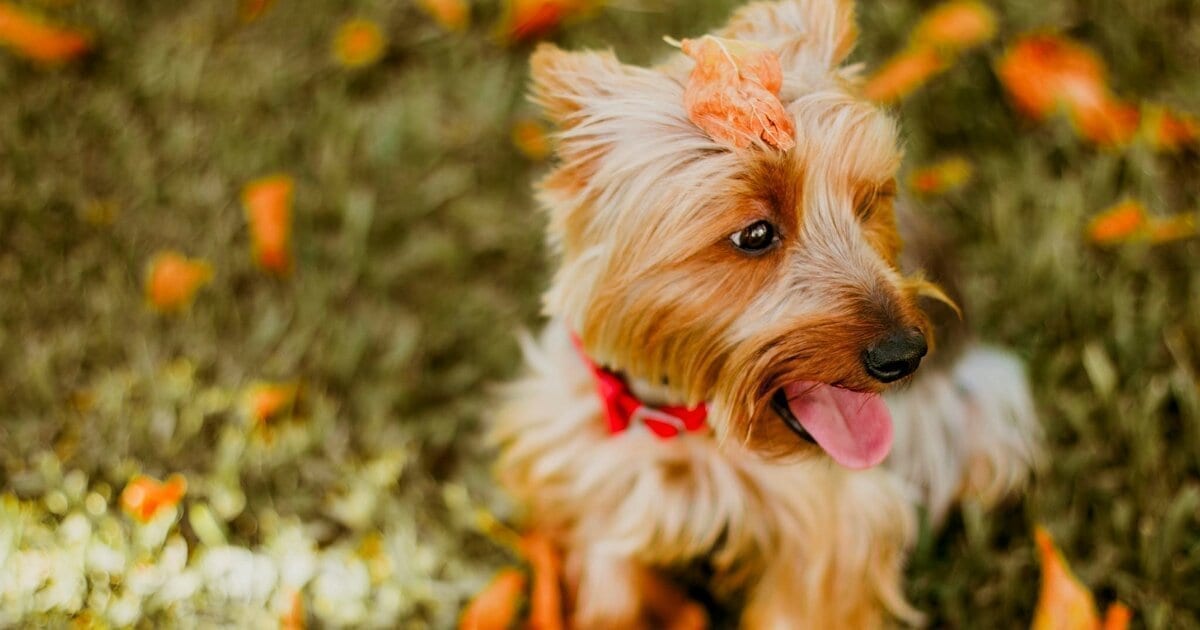
Fall brings new growth including late-blooming flowers, plants, and produce. Unfortunately, not all of autumn’s gifts are safe for our nosy pups. In addition to the outdoor hazards, seasonal decorating, cooking, and baking bring their own set of fall dog dangers.
Below is an extensive list of hazards your pooch is likely to encounter this fall and how you can help protect them from harm.
Outdoor Fall Dog Dangers
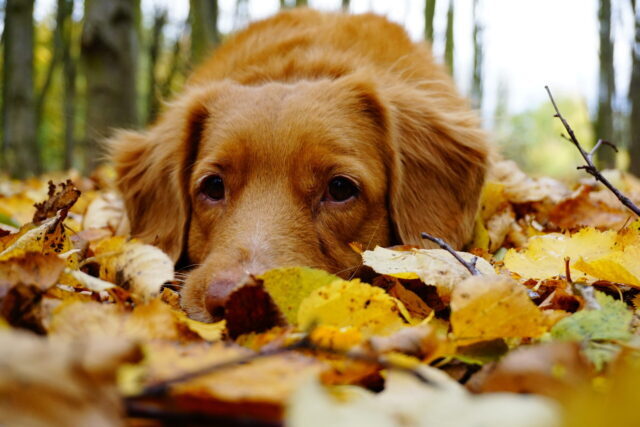
1. Acorns
Oak trees shed acorns each fall along with their leaves. The hard shells contain the trees’ seeds and while they are a source of nourishment for many species of wildlife, they can be dangerous if ingested by pets.
Acorn seeds contain tannic acid which causes digestive upset, and in extreme cases, liver and kidney damage. Signs of tannic acid poisoning include vomiting, diarrhea, abdominal pain, and lethargy.
Dogs are unlikely to suffer organ damage from eating one or two acorns. The issue is more common in grazing animals that have repeat exposure to the seeds. However, curious pups should be monitored during fall walks to prevent digestive upset, choking, and intestinal blockage from acorn nuts.
2. Autumn Crocuses
This lovely plant is also known as the Meadow Saffron. It is a perennial that blooms in the fall and contains colchicine, a chemical extremely toxic to dogs and cats.
Symptoms of ingestion include vomiting, bloody diarrhea, respiratory failure, and central nervous system signs such as weakness and seizures. The Autumn Crocus can also cause multi-organ failure by decreasing the production of red blood cells, lymphocytes, and platelets. These cells are responsible for oxygen delivery, immunity, and blood clotting respectively.
The signs of colchicine poisoning may appear immediately, but can also be delayed for days. If you suspect your dog has ingested Autumn Crocus, seek veterinary attention immediately and bring the plant along for identification.

3. Chrysanthemums
Chrysanthemums are a popular and colorful fall flower that contains pyrethrins, chemicals considered mildly toxic to dogs. The severity of symptoms depends on how much the dog eats, and include vomiting, diarrhea, drooling, and wobbliness.
Pyrethroid toxicity is more common in cats, but it is still a good idea to avoid these fall flowers and seek prompt vet care if your dog ingests them.
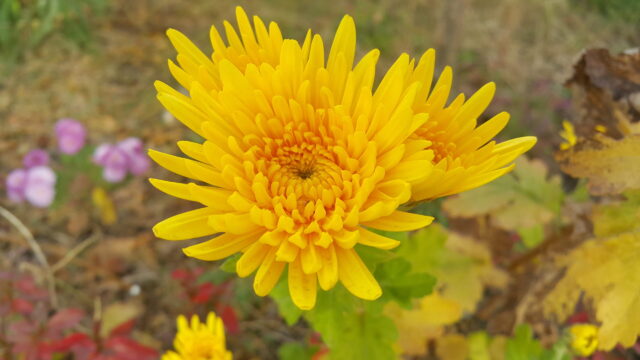
Check out the ASPCA’s extensive list of Poisonous Plants.
4. Mushrooms
Fall is mushroom season, and while 99% of these fungi are non-toxic, the few that are dangerous are especially life-threatening for dogs. Some common species of wild-growing mushrooms contain the lethal compound muscarine which dogs are especially sensitive to. Scleroderma mushroom can also be toxic.
Signs of mushroom poisoning include vomiting, diarrhea, slow heart rate, respiratory problems, liver/kidney damage, or neurological symptoms depending on the type of mushroom and the amount ingested. As adoring dog dad, Dwayne “The Rock” Johnson learned the hard way, mushroom toxicity can be fatal.
Since mushrooms are difficult to identify, the best way to keep your dog safe is to remove all fungus from your property and keep your pup on a short leash during walks to avoid accidental ingestion.
5. Moldy Leaves
Damp leaf piles often contain mold and bacteria which can cause respiratory symptoms in allergic dogs. Additionally, fall leaf piles may contain traces of toxic plant matter. Not to mention creepy crawlies like fleas, ticks, mites and snakes that love to hide out in leaf piles.
It is best to rake and remove leaves from your property and prevent your dog from rooting around in old leaves during fall outings.
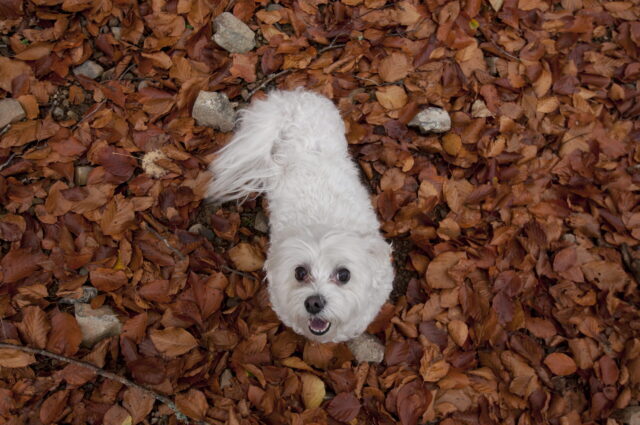
6. Parasites
Cooler weather does not mean that fleas and ticks magically disappear. Disease-carrying parasites are tricky and can hide out in your home and yard just waiting for a host.
Fleas are an itchy nightmare and can infect your dog with tapeworms. Infected ticks can pass on Lyme disease, Rocky Mountain spotted fever, ehrlichiosis, and more. And don’t forget mosquitoes. Depending on where you live, these buggers are a problem well into the autumn months so your dog is still at risk for heartworm disease.
Make sure to follow your veterinarian’s recommendations for flea, tick, and heartworm prevention all year-round.
7. Snakes
Snakes are cold-blooded and must hibernate during the colder months. In early autumn they are busy preparing for their winter snooze, putting curious dogs at risk for a dangerous encounter.
Pet parents should know which kinds of venomous snakes live in their area and where they are most likely to be found so they can avoid those environments during snake season.
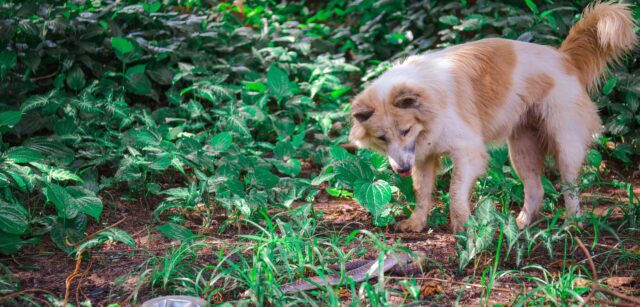
8. Antifreeze
Ethylene glycol engine coolants are a major fall risk for pets. They have a sweet taste dogs and cats like, plus they are extremely toxic and often fatal if ingested.
Consider switching to a propylene glycol-based coolant. They are still dangerous for pets, but are much less toxic than other engine coolants. You should also take care to wipe up any spills and keep these products well out of reach of children and pets.
If there is any chance your dog drank antifreeze, head to the vet immediately! Ethylene glycol poisoning causes acute kidney failure and time is of the essence to save your pup’s life.
Indoor Fall Dog Hazards

9. Potpourri
Fall scents make the season, and liquid potpourris and essential oils are excellent ways to bring the crisp aromas of autumn into your home. Some pet parents even use safe essential oils for holistic purposes. Unfortunately, many of these products can also be dangerous for dogs, including:
- Oil of Cinnamon
- Pennyroyal
- Peppermint
- Pine
- Sweet Birch
- Tea Tree (Melaleuca)
- Wintergreen
- Ylang Ylang
Ingestion of these chemicals can damage the liver, especially in puppies, senior dogs, and those with pre-existing liver problems. Liquid potpourris and some essential oils can also cause irritation and burns to the skin and mouth.
Symptoms include difficulty breathing, difficulty walking, drooling, vomiting, muscle tremors, pawing at the mouth, or burns on the lips, gums, tongue, or skin.
If you believe your dog is suffering from a reaction to essential oils or liquid potpourri, call your veterinarian immediately.
10. Candles
Speaking of chemical fragrances, fall candles can also make dogs ill and pose a fire or burn hazard. Most scented candles are made from paraffin wax, soy, or beeswax, none of which are toxic to dogs. However, depending on which fragrance is used and how much is ingested, you could run into the same problems as above.
There is also a chance that boisterous dogs will knock candles over or burn themselves if candles are left within reach. To protect your pooch, choose natural, pet-safe scents, keep candles well out of reach on steady surfaces, and never leave them burning when you are not home.
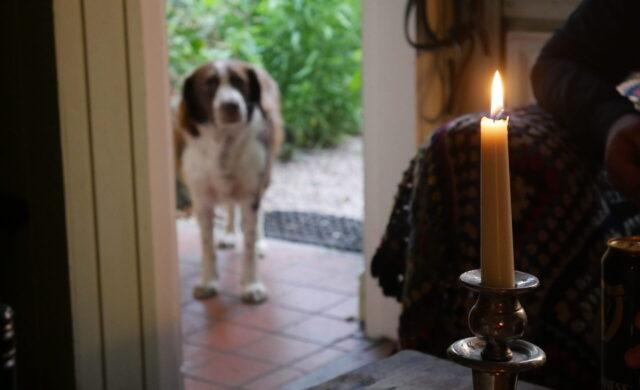
11. Mothballs
Fall is the time to break your cozy sweaters out of storage once again, but if you use mothballs to keep the bugs away, your pup could be in danger. Mothballs contain a high concentration of the insecticides napthalene, paradichlorobenzebe (PDB), or camphor – all of which are toxic to dogs.
Ingestion can cause vomiting and lethargy, or even life-threatening issues like anemia or liver and kidney damage. They also pose a choking or intestinal blockage hazard if swallowed.
12. Rodent Poison
In the fall, rodents search for warm, safe places to wait out the colder months which may bring them into our homes. Before you lay traps, keep in mind that over-the-counter Warfarin rodenticide is extremely toxic and often fatal for pets.
These products destroy an animal’s blood-clotting abilities. If a dog eats rat bait or the body of a rodent that has, it can result in massive internal bleeding. Early signs of ingestion include coughing, difficulty breathing, rapid breathing, exercise intolerance, and swollen joints. Without treatment, this will progress to bleeding from the nose, mouth, or rectum, and eventual death.
Immediate veterinary care should be sought if you even suspect ingestion. Be sure to bring the remaining product and ingredient information with you to help the vet determine a treatment plan.
Dangerous Fall Foods To Avoid Sharing With Your Pup
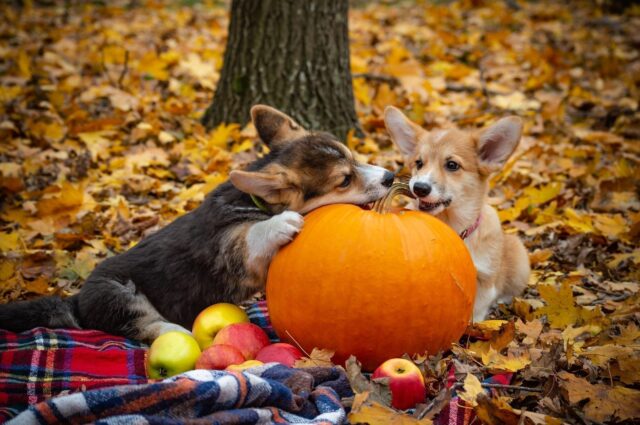
13. Corn Cobs
Corn is traditionally harvested in September and October making it a fall staple in cooking and decorating. Many dogs love to chew on the firm-but-yielding cobs for a taste of the sweet kernels and the pleasing texture. Unfortunately, swallowing large chunks of cob can lead to choking, gastrointestinal injuries, and life-threatening obstructions.
14. Apple Seeds
Apples are another iconic symbol of fall and a favorite in autumn recipes, but did you know that the seeds contain the toxin cyanide? In fact, cyanide can be found in all parts of the apple plant except the flesh of the fruit itself.
Luckily, the concentration of toxin is very low and the seeds must be chewed in order to release cyanide. For these reasons, most dogs that eat too many apples only end up with a stomachache and maybe some vomiting or diarrhea.
However, it is still a good idea to keep dogs away from fallen apples (including crab apples) this fall. Enough cyanide can affect the body’s ability to transport and use oxygen resulting in difficulty breathing, shock, and even death.
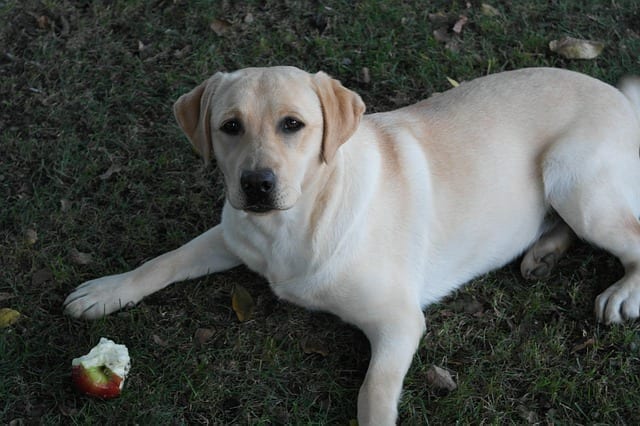
15. Baked Treats
There is something about fall that just makes you want to bake, but use caution with the following ingredients:
- Baker’s Chocolate and Cocoa Powder: Since these products are incredibly concentrated they contain high levels of theobromide, the stimulant that causes chocolate toxicity in dogs.
- Macadamia Nuts: What makes macadamia nuts dangerous for dogs is unknown, but even a few can be incredibly toxic causing vomiting and neurological symptoms.
- Raisins: Like macadamia nuts, vets aren’t sure why some dogs suffer acute kidney failure when they eat grapes and raisins.
- Nutmeg: The small amount of nutmeg used in baking is unlikely to harm your dog, but you may have a problem if he get into the container. The compound Myristicin in nutmeg raises heart rate and blood pressure and may cause seizures.
16. Cooked Bones
Fall football parties are the perfect time for hot wings and autumn festivals often serve massive turkey legs. These treats are fine for humans, but the splintery bones are dangerous for your pooch. Cooked bone shards can cause choking and serious damage to your dog’s mouth, throat, and digestive tract.
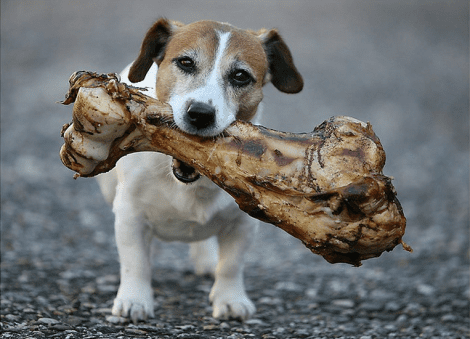
17. Onions
So many of our favorite fall recipes include onions and other root vegetables from the Allium genus like shallots, leeks, and chives. While your dog would have to ingest very large quantities to become ill, it is best to avoid sharing foods made with onions with your dog.
18. Alcohol
Fall brings several opportunities to celebrate with friends and family. Should you decide to serve alcohol at these get-togethers, be sure your dog does not imbibe. Even a small amount of alcohol – including that in syrups and raw bread dough – can depress the nervous system and damage the kidneys.
If your dog consumes alcohol, you may see signs including vomiting, disorientation, difficulty urinating, and dehydration. Other more serious signs include collapse and seizures. If left untreated, alcohol intoxication could result in organ failure and death so seek vet care immediately.
Halloween Hazards

19. Costumes
Halloween costumes for pets are adorable, but they also tend to be cheaply made. Synthetic materials and poor construction mean these outfits can easily get caught on something, irritate the skin, cause heatstroke, or even become a choking hazard.
If you do decide to dress up your dog, make sure he only wears his costume under your direct supervision.
20. Halloween Candy
As mentioned above, the chemical theobromide found in chocolate is hazardous to dogs. It is most concentrated in dark chocolate and baking chocolate, but too much Halloween candy can still cause problems.
Some dogs develop vomiting and/or diarrhea while those with full-on chocolate toxicity suffer from heart palpitations, agitation, hyperactivity, muscle tremors, high blood pressure, and seizures. Signs appear anywhere from 4-24 hours following ingestion, but the sooner you seek treatment the better. Be sure to inform the vet how much chocolate your dog ate so he or she can determine if it is a toxic dose.
The sugar-free sweetener xylitol is also quite toxic to dogs. It is most often found in gums, mints, and breath fresheners, but several low-calorie and sugar-free candies also have xylitol. Check this extensive list from Preventive Vet and seek veterinary attention immediately if your pup ingests any xylitol-containing product.
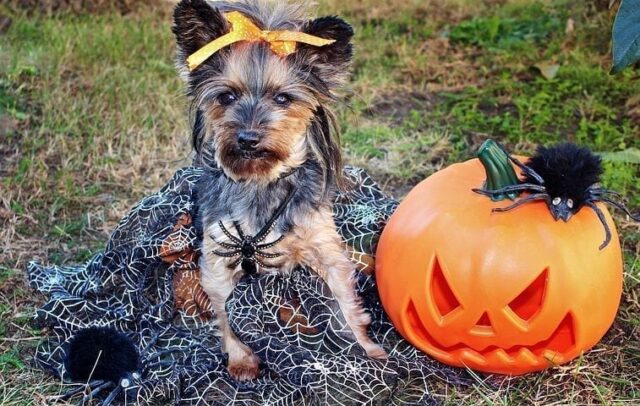
21. Glow Sticks
As trick-or-treaters and revelers head out into the evening, many light their way with glow sticks and luminescent jewelry. The chemical mixture inside these products is very irritating to your dog’s gums and may cause drooling, foaming at the mouth, and vomiting. Thankfully, unlike most of the other items on this list, glow sticks are unlikely to cause serious health problems.
These additional Halloween tips will help ensure your dog stays safe and happy on fall’s spookiest holiday.
The post 21 Fall Dog Dangers To Avoid This Autumn appeared first on iHeartDogs.com.
from iHeartDogs.com https://ift.tt/3couWET https://ift.tt/32OXVP2
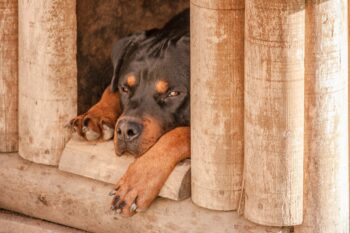
No comments:
Post a Comment